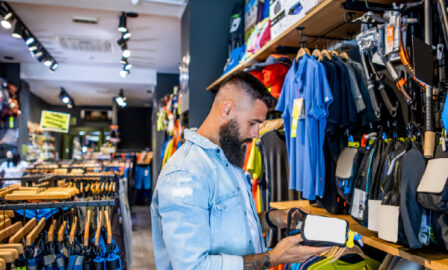2023 Apparel Industry Trends
Read our updated trends report here: 2024 Apparel Industry Trends
Clarkston’s team of apparel consultants have highlighted the top apparel industry trends that businesses should consider. Read all five trends for 2023 by downloading the full report here.
The apparel industry continues to evolve to find creative ways to keep up with ever-changing shopper demands. In 2023, prominent trends shaping the apparel industry center around sustainability, consumer preference, supply chain implications, and influences from technological advancements.
2023 Apparel Industry Trends
Trend #1: Conscientious consumers are forcing brands to rethink sustainable apparel
Sustainability in apparel continues to be an industry focus. We’re seeing retailers changing their sourcing strategy, and in some cases changing their raw materials altogether. Considering the clothing and textile industry reports an annual material loss of $100 billion due to the underutilization of materials, the popularity of recycling and reselling of apparel continues to grow, and transparency in the supply chain has become table stakes for retailers.
One creative way to create more eco-friendly clothing is to substitute traditional fabric with bamboo fabric. Using bamboo as a sustainable material in collections is becoming more prevalent. Other ways to promote sustainability are through secondhand shopping as well as returning articles of clothing to recycle or resell at a discount. This trend is continuing to be on the rise for apparel across brands as consumers become more educated on sustainability.
As consumers also continue to expect manufacturers to deliver products at high speed, this demand puts pressure on our environment and encourages preventable waste. Traditionally, manufacturers have followed a linear take-make-waste model; however, consumers are demanding retailers maximize waste-reduction efforts at every production stage, which poses new challenges for apparel brands to protect ever-tightening margins. As such, there has been a shift to bring manufacturing onshore to have more control over distribution and ethical operations. Traditionally, offshoring manufacturing plants were a common practice to offset the cost of making goods, but consumers are voicing their disapproval of working conditions for workers overseas, and companies are making changes to address these concerns – all efforts toward a more sustainable apparel industry.
Download the Full 2023 Apparel Industry Trends Report Here
Trend #2: Consumers continue to desire customization and personalization
More than ever, retailers are incentivized to offer their customers a personalized shopping experience. Similarly, apparel brands must find creative means to offer tailored-made apparel, keeping the customer at the center of mind. With advancements in technology, it’s becoming easier to have direct access to manufacturers to provide customized apparel with the specifications determined by the customer.
Market research shows that fully customizable apparel could claim 10 to 30% of the market share by 2030, and this growth will utilize consumer insight to drive inventory. Just-in-time manufacturing has become a critical capability for apparel manufacturers as personalized offerings typically involve custom fabrics. While customized apparel allows companies to purchase to order, reducing inventory holding costs and potential waste, the increased costs are often passed to the consumer. Continue reading by downloading the full report below.
Download the Full 2023 Apparel Industry Trends Report Here
Subscribe to Clarkston's Insights
Contributions from Tigist Abebe



